- jwebb's home page
- Posts
- 2019
- 2018
- 2017
- 2016
- 2015
- 2014
- 2013
- November (1)
- October (1)
- September (1)
- July (1)
- June (1)
- April (1)
- March (3)
- February (1)
- January (1)
- 2012
- 2011
- December (2)
- September (3)
- August (5)
- July (6)
- June (6)
- May (1)
- April (5)
- March (5)
- February (2)
- January (2)
- 2010
- December (3)
- October (3)
- September (2)
- August (2)
- June (2)
- May (4)
- April (4)
- March (2)
- February (4)
- January (10)
- 2009
- 2008
- 2007
- 2006
- July (1)
- My blog
- Post new blog entry
- All blogs
Geometry differential: y2009 vs y2009a
Abstract: The impact of recent changes to the EEMC geometry on the full STAR geometry is tested. We examine the change in size, composition and position of detector volumes in the geometry model. Most changes are confined to the fiducial volume containing the EEMC. Several changes are observed in the magnet poletip behind the EEMC. These are likely the result of roundoff errors accumulated in tracking geantinos through an altered EEMC geometry.
Conclusion: We find no significant changes in the y2009a geometry, beyond what was expected given the changes to the EEMC.
0.0 Methodology
- The y2009 and y2009a geometries are instantiated.
- The full 4π solid angle is divided into 800 bins in theta and 800 bins in phi.
- One geantino per bin is generated.
- Histograms are filled plotting 4 quantities vs position (r,z) where the geantino enters the volume. These quantities are:
- Number of geantinos entering a volume in the given histogram bin.
- Radiation length
- Path length through the volume
- Distance from the origin of the volume
- For y>0, histogram is filled with R=r. For y<0, histogram is filled with R=-r.
- Radiation length, path length and distance histograms are normalized to the number of geantinos.
- A difference between two geometries is made and plotted.
1.0 Changes in Composition
To test for changes in composition, we compare the radiation length reported by the material in the volume between y2009 and y2009a.

Figure 1.2 -- Radiation length plot for geometry tag y2009a. Geantinos are thrown and tracked through the STAR geometry. The radiation length of each volume is entered into the histogram at the point where the geantino enters the volume.
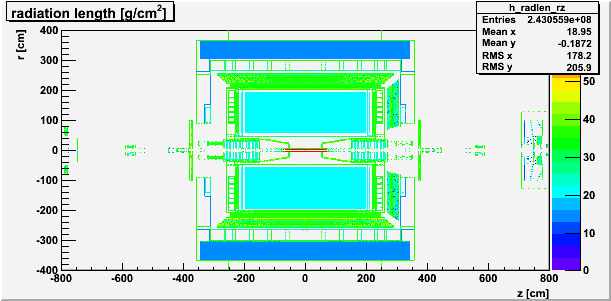
Figure 1.3 -- Radiation length differential. The y2009a geometry is subtracted from the y2009 geometry. The difference is plotted using ROOT's "box" option.
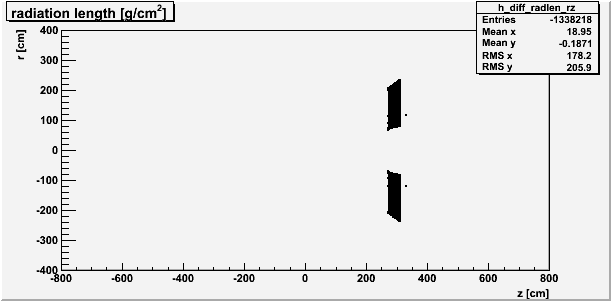
Discussion:
Examining the difference plot, we see that most of the changes are confined to the EEMC volumes (roughly in the z-range from 260 cm to 310 cm). Two points in the magnet poletip show a difference, however. These are the two points at r=+/- 118 cm and z=326 cm. On close examination, the difference appears to be roundoff error in tracking. One geometry claims that there are no geantinos entering a volume in the specified histogram bin, the other claims exactly one geantino.
We conclude that there are no significant changes in radiation length outside of the EEMC.
2.0 Changes in Shape
To test for changes in shape (dimension and/or actual shape), we plot the difference in the path length which a geantino takes through a given volume.
n.b. Units are not in cm... possibly in g/cm^2. Need to trace what fCurrentLength corresponds to in the code.
Figure 2.1 -- Path length plot for geometry tag y2009. Geantinos are thrown and tracked through the STAR geometry. The path length through each volume is entered into the histogram at the point where the geantino enters the volume.
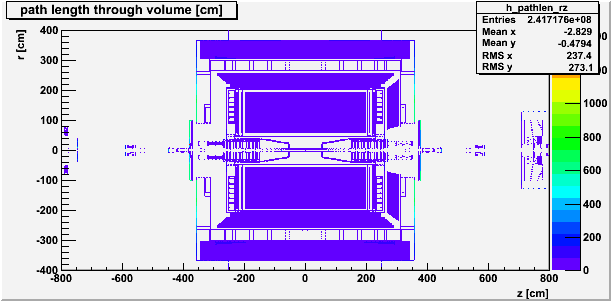
Figure 2.2 -- Path length plot for geometry tag y2009a. Geantinos are thrown and tracked through the STAR geometry. The path length through each volume is entered into the histogram at the point where the geantino enters the volume.

Figure 2.3 -- Path length differential. The y2009a geometry is subtracted from the y2009 geometry. The difference is plotted using ROOT's "box" option.
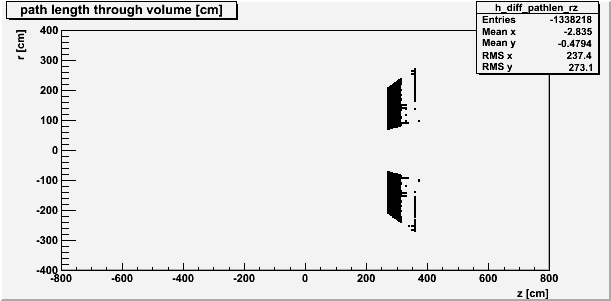
Discussion:
Once again, most of the differences are seen in the EEMC volumes. Several additional changes are seen in the poletip behind the EEMC. On closer examination, these changes are on the order of a few microns. These changes are small and likely reflect the accumulation of small roundoff errors in tracking.
(The exceptions are the two points noted previously at r=+/- 118 cm.)
Again we conclude that there are no significant differences between y2009 and y2009a when examining the path lengths geantinos take through detector volumes.
3.0 Changes in Position
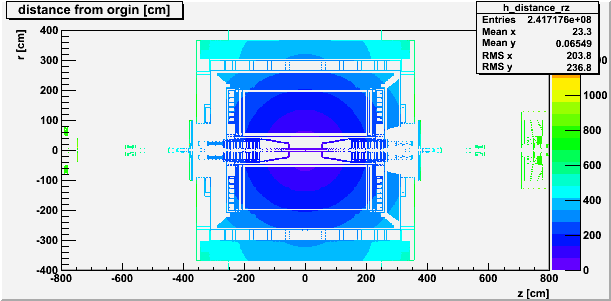
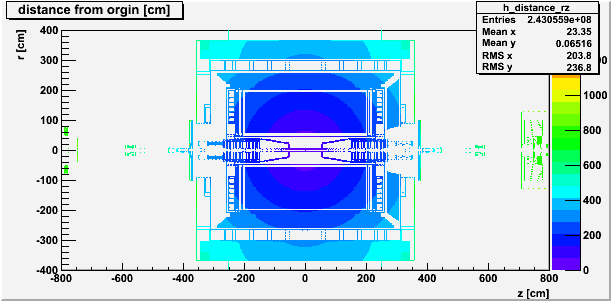
Figure 3.3 -- Position differential. The y2009a geometry is subtracted from the y2009 geometry. The difference is plotted using ROOT's "box" option.
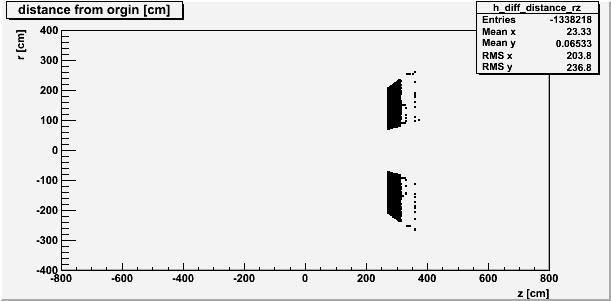
Discussion:
Differences in the mean positions of detector volumes are primarily confined to the EEMC. There are differences at the few micron level observed in the poletip, but again these are likely due to accumulated roundoff errors in tracking through the changed EEMC geometry.
We see no significant changes outside of the EEMC.
- jwebb's blog
- Login or register to post comments
